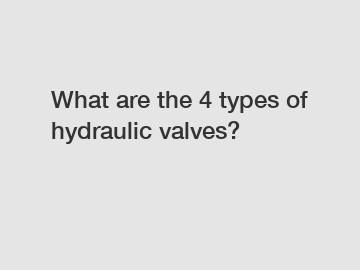What are the 4 types of hydraulic valves?
What are the 4 types of hydraulic valves? In hydraulic systems, valves play an integral role in controlling the flow, pressure, and direction of fluid. The four types of hydraulic valves commonly used are the directional control valve, pressure control valve, flow control valve, and check valve.
The directional control valve is responsible for controlling the flow of fluid and changing the direction of the hydraulic system. It allows the fluid to flow in different paths, enabling the system to perform various functions. This valve is crucial in hydraulic machinery such as excavators, cranes, and forklifts, where precise control of movement is required.
On the other hand, the pressure control valve ensures that the hydraulic system operates within a safe pressure range. It prevents excessive pressure build-up, which could damage the system or cause safety hazards. This valve is commonly found in hydraulic presses, powerpacks, and hydraulic cylinders, where controlling pressure is essential.

Flow control valves regulate and control the speed and volume of fluid flow in a hydraulic system. These valves maintain the flow rate within a desired range, preventing sudden surges or inadequate flow. Flow control valves are commonly used in hydraulic machines that require precise and smooth movement, such as injection molding machines and hydraulic lifts.
Lastly, the check valve allows fluid to flow in only one direction, preventing the backflow of fluid. It ensures that the hydraulic system functions efficiently and prevents potential damage caused by reverse flow. Check valves are commonly used in circuits where backflow could cause severe damage, such as hydraulic braking systems and powerpacks.
The importance of understanding the different types of hydraulic valves lies in the ability to design and operate efficient hydraulic systems. By selecting the appropriate valve for each application, engineers and operators can ensure optimal system performance, longevity, and safety. Additionally, proper valve selection can lead to energy efficiency and cost savings, as it allows for precise control of fluid flow, pressure, and direction.
To determine the suitable valve for a specific application, one must consider factors such as flow rate, pressure requirements, system size, and desired control precision. Various industrial standards and guidelines provide detailed information on valve selection, ensuring the correct choice for different hydraulic circuits.
In conclusion, the four types of hydraulic valves - directional control valve, pressure control valve, flow control valve, and check valve - are essential components in hydraulic systems. Understanding their functions, applications, and selection criteria is crucial for designing efficient and safe hydraulic systems. The proper utilization of hydraulic valves can contribute to improved equipment performance, reduced energy consumption, and enhanced operational reliability in various industries.
The company is the world’s best Electromagnetic Relief Valve, wholesale one way hydraulic check valve, Proportional Valve Overflow Valve supplier. We are your one-stop shop for all needs. Our staff are highly-specialized and will help you find the product you need.


